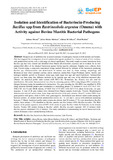| dc.description.abstract | Rampant use of antibiotics has increased resistance of pathogenic bacteria in both animals and humans.
This has triggered the investigation of novel antimicrobial agents produced by a bacterial strain of low virulence
with antimicrobial activity with a wide range of clinical significance. This study sought to extract bacteriocins from
Bacillus spp that were isolated and identified from Omena (Rastrineobola argentea) and to evaluate the in vitro
antimicrobial effect of the obtained bacteriocin against bovine mastitis pathogens. Samples were collected from
Lake Victoria using a completely randomized design method followed by isolation of the bacteriocin producing
Bacillus spp. Characterization and identification of isolates was done by Gram staining, morphology and
Biochemical tests which included catalase, nitrate reduction, methyl Red,-Voges-Proskauer, indole, motility and
hydrogen sulphide, growth on Simmons citrate agar, triple sugar iron agar and starch hydrolysis. Antimicrobial
activity was done using disc diffusion methods on the nutrient agar and zone of the inhibition measured after
24hours. An analytical profile index system (API 50CH BE, Biomerieux, Inc, France), was also used for
identification. Molecular characterization was done by extracting genomic DNA using Qiagen DNA isolation Kit
(Qiagen Germany) using the manufacturer's instructions. The gene encoding the 16S rRNA was amplified by PCR
using universal bacterial primers pair combination of forwarding primer 27F forward (5′-AGA GTT TGA TCC
TGG CTC AG-3′) and 1492R reverse, (5′-GGT TAC CTT GTT ACG ACT T-3′) about Escherichia coli gene
sequence. A total of 60 pure isolates were obtained from Omena samples from Lake. Victoria. Morphological
characteristics showed varied colour, form, shape and elevation of the pure colonies. About 54 isolates (90%) were
gram-positive with spores, while 6 (10%) were gram-negative. Biochemical tests showed varied results among the
bacterial isolates. 28 isolates showed antimicrobial activity on E. coli and S. aureus with inhibition measuring
between 17-30mm. Analytical profile index system also showed that 20 isolates (71%) were identified as Bacillus
subtilis, three isolates (11%) identified as Bacillus pumilus and five isolates (18%) Bacillus mycoides. The Blast
analysis of the partial sequences showed100% of the strains of genus Bacillus within the Firmicutes in the domain
bacteria. Twenty (20) isolates belong to Bacillus subtilis, Bacillus mycoides represent 18% (5 isolates) while
Bacillus pumilus constituted 11% (3 isolates). This study contributes to understanding the use of bacteriocin in the
control of diseases in dairy animal farming in Kenya. | en_US |

